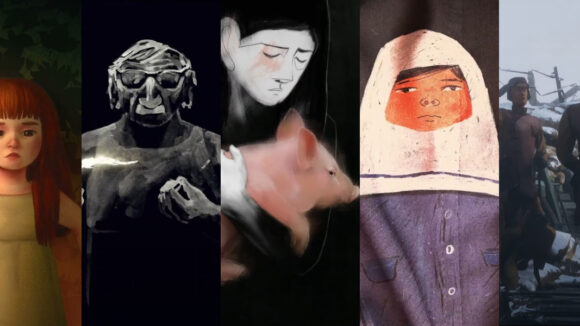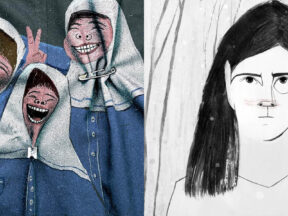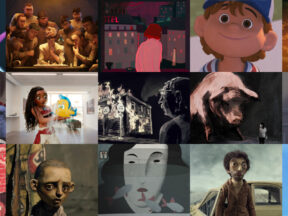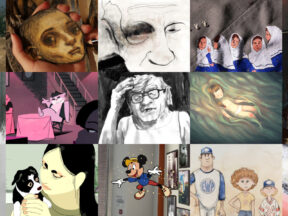

Watch The Filmmakers’ Favorite Shots From This Year’s Five Oscar-Nominated Animated Shorts
Oscars voting kicks off on Thursday, February 22. To help voters learn more about what they’re voting on, we’ve put together a list of the favorite shots from filmmakers behind all five animated short nominees.
In addition to sharing the shots, the filmmakers explained what makes each clip special to them. Here is what the 2024 animated short nominees had to say.
Pachyderme
Director: Stéphanie Clément
Of all the shots in the film, I chose this one as my favorite because it served as the first test shot and illustrates a key psychological defense mechanism at the heart of the story: dissociation. Louise escapes from an experience too heavy to bear by letting herself sink into an imaginary world, by mentally projecting herself out of her bed into the flowery decor of the wallpaper until she disappears entirely. The same idea is echoed in the soundtrack, with the rustling of foliage gradually making itself heard but without managing to drown out the creaking sounds of the wooden floor completely. The almost monotone, disembodied voice of adult Louise, played by actress Christa Theret, betrays the state of emotional anesthesia in which she is immersed.
Louise is an unobtrusive, silent, overly well-behaved little girl, which is reflected by a frozen attitude, an inexpressive face, and slow, withdrawn, tinged with hesitation, almost clumsy gestures. A minimalist, self-restrained acting style, partly inspired by the performance of the children in the films Cría Cuervos (Carlos Saura, 1976) and The Seventh Continent (Michael Haneke, 1989).
The orange-brown floral wallpaper, which was common in the French middle-class interiors in the 1960s and 1970s, reproduces a motif I encountered as a child and which I wanted to transpose identically for the film. At the time, it was a source of unease and fear for me because what I saw was not flowers or foliage but a mass of staring faces and tangled bodies. When I saw it again years later to prepare this film, I found it hard to see anything other than vegetation.
This shot is also a great example of collaboration between traditional animation studio Folimage and TNZPV studio’s 3d teams. The floral motifs – animated in 2d by the talented Marc Robinet – needed to grow and wrap Louise – animated in 3d by the no less talented Marthe Delaporte – with a slow delicacy, like tucking a child into bed. I think the two techniques combine harmoniously here, helping to make this shot one of the most significant in the film.
Ninety-Five Senses
Directors: Jared and Jerusha Hess
Ok, this is hard. And in the case of Ninety-Five Senses, with its six unique styles, it’s even harder. But what Daniel Bruson achieved in this long, single shot is breathtaking.
Landing the plane is always the hardest part of filmmaking. You are constantly searching for ways to end your story with the strongest emotional impact — and we think Daniel nailed it. He somehow captured everything we had just experienced in the film but then revealed something new, heartbreaking and beautiful.
His camera work, transitions and storytelling were totally inspired. And he hand-painted everything using ink and paper.
Letter to a Pig
Director: Tal Kantor
This shot from the film is inspired by a memorable moment from a dream I had as a young schoolgirl. I vividly recalled details from that dream for years, like the weight of a little pig shaking in my hands and its soft touch. This memory left such a powerful mark on me, and over a decade later, along with a few other memories, it eventually turned into a strong desire to create this film.
This shot marks the pivotal turning point in the film when the young heroine, Alma, undergoes a significant change in perspective. She decides to listen to her conscience’s command and takes corrective action.
This moment unfolds immediately after Alma witnesses the consequences of her and her classmates’ fear and animosity toward the unfortunate pig. She decides to take action, extending her hands upward to gently lower the pig, untangling it from the threads of cruel hatred in which it was trapped.
This moment initiates a process of self-reflection and shrinking of the great fear, allowing the pig to return to a small and tender state in Alma’s hands. It marks the beginning of an inner reconciliation.
Despite numerous attempts and challenges, the team and I ultimately succeeded in producing and realizing this intricate shot just as I had envisioned.
I aimed for this moment to portray a genuine and trustworthy connection between Alma’s mature hands and the soft pig’s body, where the boundaries between dream and reality would blend into one another.
Therefore, It was important to me (and almost throughout the film) to use footage of real hands, not drawn ones. This choice aimed to emphasize and provoke reflection on the movements and actions we perform with our human hands. Do we clench them into a fist or open and extend them towards others? Are they used to cause harm or to embrace and comfort?
This shot captures a moment of connection, marking the first touch of compassion and tenderness, which embodies the essence of the entire journey and message of the film.
Our Uniform
Director: Yegane Moghaddam
This shot stands out to me because there was a lot of improvisation involved in making it.
Initially, it was an important shot for me because it opens up a dialogue on individuality and self-expression. After introducing “our schools,” “our classes,” “our uniforms,” “our teachers,” “our moderators,” etc., here is the first time you hear the single pronoun “I,” to talk about oneself. When I planned it in my storyboards, I decided to undo the buttons one by one only to discover that there’s a big void inside her, implying her lack of self-identity and the inability to talk about her desires. But the result failed to amuse me. The tone was moralizing and cliche.
I realized I’d been blind to the possibilities of animation and decided to take a new turn on that shot. This time I added the zippers right under the buttons to emphasize how deep she should dive to explore her real desires. While I was doing the zipper, I thought, let’s add one more layer with safety pins and then another layer with patches, etc… I could go forever on that shot and never reach her deepest depth. But at some point I had to stop, and I did.
I’m really happy that I used a mixed-media technique for it did avail me of one advantage: Endless combinations and therefore endless visual possibilities.
I need to add that everything was done inside the software. After I had my stop motion footage prepared, I composited all the clips beneath one another to create that layered effect.
Last but not least, I like to believe that this shot sums up the entire film and says all I ever wanted to say. Quite poetically and economically.
War is Over! Inspired by the Music of John and Yoko
Director: Dave Mullins
This is the first shot that I could see in my mind when writing the script for War is Over!. With John and Yoko’s anti-war message being the entire reason for making this film, I wanted a shot early on that represented that message from an emotional point of view. I also wanted it to be a touchstone for other shots stylistically and signal the audience what type of film they’re about to watch. For me, this shot is an homage to my favorite filmmakers – Hayao Miyazaki, Ridley Scott, and Stanley Kubrick, among others. It’s this type of visual language that makes their films so engaging and re-watchable.
One way to make a shot like this really stand out is by combining two primal elements on screen, which is meant to evoke a gut-level emotional response from the audience. It’s like a filmmaking haiku. A simple example of this is when you see a burnt-out car. The combination: car and fire. You immediately know what happened. The story is obvious to anyone in any language. It’s visual.
For War is Over!, we used blood and snow as our two primal elements. The shot starts on freshly fallen snow; the Sergeant steps through the frame, leaving behind a boot print that fills with blood. You quickly get a sense of how long the war has been raging on and the soldiers’ situation. Those two combined elements give us a lot of information.
We also wanted to quickly establish a sense of the relationship between the Sergeant and his soldiers. Chain of command is very important to the film. We needed to illustrate the suffering and the terrible situation they are living in. It is bone-chillingly cold; snow is falling, mixed with a frozen mist.
We designed the combination of those elements to deliver depth and atmosphere within the shot, skillfully crafted by our production designer, Zac Retz, and visual effects supervisor Keith Miller’s team at Wētā FX.
From a camera and performance standpoint, I worked out the shot with our director of photography, Antonio Riestra, on stage. Then, we continued to develop the look of the shot at Wētā FX with Aidan Martin (animation supervisor) and David Scott (digital director of photography), who worked closely with me to make these multiple elements work together.
Finally, with the elements layered in, we see our hero pigeon flying low near the trench and the soldiers, intimately connected to the war activity. We made a choice to clearly declare that she isn’t above the conflict; she’s part of it.
It is a lot to pack into one shot, but in less than 8 seconds, we introduce the war, the harsh environment, the Sergeant and soldiers, the chain of command, the pigeon’s role in the war, and the hell they are all living in. All of it paints a picture of the human condition and its place within the horrors of war.
With everything going on in the world today, we really wanted to get this messaging correct, both from an emotional and visual point of view. Although a shot like this really focuses on the hell of war, we hope the audience leaves the theater really feeling John and Yoko’s message of peace that they sang so passionately about over 50 years ago.
Pictured at top: Pachyderme, Ninety-Five Senses, Letter to a Pig, Our Uniform, War is Over! Inspired by the Music of John and Yoko




